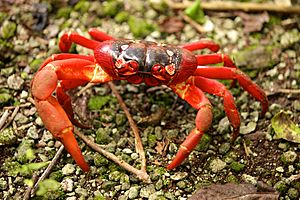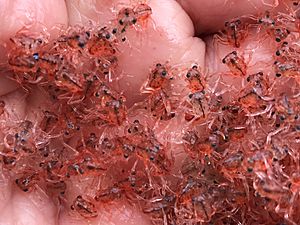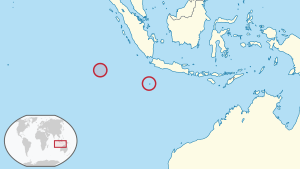Christmas Island red crab facts for kids
Quick facts for kids Christmas Island red crab |
|
|---|---|
 |
|
 |
|
| Megalopae of the crab | |
| Scientific classification | |
| Genus: |
Gecarcoidea
|
| Species: |
natalis
|
 |
|
| Distribution map of Christmas Island red crab | |
The Christmas Island red crab (Gecarcoidea natalis) is a special type of land crab. It lives only on Christmas Island and the Cocos (Keeling) Islands. These islands are located in the Indian Ocean.
These crabs are famous for their amazing yearly journey. Millions of them march to the sea to lay their eggs. This event is so huge it can cover roads!
Sadly, these crabs face a big threat. An invasive insect, the yellow crazy ant, has caused a lot of harm. These ants have killed many millions of red crabs. Scientists are working to protect these unique creatures.
Contents
What Do Red Crabs Look Like?
Christmas Island red crabs are quite large. Their hard outer shell, called a carapace, can be up to 11.6 centimeters (about 4.5 inches) wide. That's roughly the size of a small dinner plate!
Their claws are usually the same size. If a claw gets hurt or falls off, it can grow back! Male crabs are often bigger than females. Adult female crabs have a wider abdomen (the lower part of their body). This wider abdomen helps them carry their eggs.
Most red crabs are bright red. But some can be orange. A few rare ones are even purple!
Ecology and Behavior
Daily Life and Habits
Red crabs are land crabs, so they breathe with gills. They need to keep their bodies moist to survive. They avoid direct sunlight to prevent drying out.
These crabs are active during the day, which is called being diurnal. However, they are mostly inactive at night. They dig burrows to hide from the sun and stay cool. A crab will often use the same burrow all year.
During the dry season, they seal their burrow entrance. This keeps the inside humid. They might stay in their burrow for three months until the wet season begins. Most of the year, red crabs live alone. They will protect their burrow from other crabs.
Amazing Yearly Migration and Reproduction
Most of the year, red crabs live in the forests of Christmas Island. But every year, they make a long journey to the coast. This is to reproduce.
The migration starts with the wet season, usually in October or November. This weather makes the crabs more active. The timing of their journey also depends on the moon phases.
During this migration, crabs leave their homes in the forest. They travel to the sea to find a mate and lay eggs. This trip can take over a week. Male crabs usually arrive at the coast first. They dig new burrows near the shore. They must protect these burrows from other males.
Mating happens inside or near these burrows. After mating, the males go back to the forest. The females stay in their burrows for about two more weeks. They lay their eggs and keep them safe in a special pouch on their abdomen.
When the eggs are ready, the females leave their burrows. They release their eggs into the ocean. This happens exactly when the tide is high, during a specific moon phase. After releasing the eggs, the females also return to the forest. The tiny crab larvae then spend 3 to 4 weeks in the sea. They later come back to land as young crabs.
The Red Crab Life Cycle
As soon as the eggs touch the seawater, they hatch. Tiny crab larvae float near the shore. Then, ocean currents carry them out to sea. They stay there for 3 to 4 weeks.
During this time, the larvae change many times. They grow into small, shrimp-like creatures called megalopae. These megalopae gather near the shore for a day or two. Then, they transform into tiny young crabs, only 5 millimeters (about 0.2 inches) wide.
These young crabs leave the water. They begin a 9-day trip to the middle of the island. For their first three years, they hide. They live among rocks, dry leaves, and fallen branches on the forest floor.
Red crabs grow slowly. They become adults and can reproduce around 4 to 5 years old. This is when they join the yearly migration. Young crabs shed their shells (moult) several times as they grow. Adult crabs moult once a year, usually safely inside their burrow. A red crab can live for about 12 years.
What Do Red Crabs Eat?
Christmas Island red crabs are omnivores. This means they eat both plants and animals. They are also scavengers, eating whatever they can find.
Their main diet includes fallen leaves, fruits, flowers, and young plants. They also eat dead animals, including other dead red crabs. Sometimes, they even eat human rubbish. They also enjoy eating the giant African land snail, which is not native to the island.
Red crabs are very good at finding food. They have little competition for food on the forest floor.
Who Are Their Predators?

Adult red crabs on Christmas Island have very few natural enemies. However, they face a huge threat from the yellow crazy ant. These ants are an invasive species that arrived by accident.
These ants have caused a lot of damage. They are thought to have killed 10 to 15 million red crabs. This is about one-quarter to one-third of the total crab population. The ants have also forced many more crabs to move from their homes.
When red crabs are tiny larvae in the sea, they have many predators. Millions of them are eaten by fish. Large animals like manta rays and whale sharks also visit Christmas Island. They feed on the crab larvae during the breeding season.
Sometimes, Coconut crabs, also called robber crabs, have been seen eating red crabs.
Some scientists think that the red crab population grew larger after 1903. This was when a native rat, the Maclear's rat, became extinct. This rat might have kept the crab numbers lower before.
How Many Red Crabs Live There?
Scientists have studied the number of red crabs. They estimate that about 43.7 million adult red crabs live on Christmas Island. This means there can be up to half a crab per square meter!
There are also red crabs on the Cocos (Keeling) Islands. However, their numbers are much smaller. Genetic studies suggest these crabs likely came from Christmas Island more recently. For protection efforts, scientists treat them as one large group.
Red Crabs and People
During their yearly migration, red crabs often cross roads. This happens as they travel to the sea and back to the forest. Sadly, thousands of crabs are crushed by cars. Their hard shells can even puncture tires, sometimes causing accidents.
To keep both crabs and people safe, local park rangers help. They set up special aluminum barriers along busy roads. These barriers guide the crabs towards small underpasses. This allows the crabs to cross the roads safely.
Other helpful structures include a five-meter-high "crab bridge." In recent years, people living on Christmas Island have become more careful. They drive more slowly during the migration. This helps to save many crabs.
Red crabs are not eaten by humans. They are small, have a lot of water in their bodies, and their meat is not very good.
Conservation Efforts
As of 2025, the Christmas Island red crab remains a species of great ecological importance. While the International Union for Conservation of Nature (IUCN) had not assessed the red crab by 2020, and it was not listed on their Red List at that time, the ongoing challenges highlight the need for continued monitoring and conservation strategies.
Interesting Facts About Christmas Island Red Crabs
- Their migration is often described as an "epic" event, with millions emerging at the same time, literally covering the ground in a thick carpet of crabs!
- The timing of their migration and egg release is precisely linked to the phases of the moon, a true marvel of natural synchronization.
- They are so numerous that they dominate the forest floor, playing a vital role in the island's ecosystem by recycling nutrients.
- Christmas Island is home to special "crab bridges" and underpasses, making it one of the few places in the world where infrastructure is built specifically for crabs!
See also
 In Spanish: Cangrejo rojo de la isla de Navidad para niños
In Spanish: Cangrejo rojo de la isla de Navidad para niños





